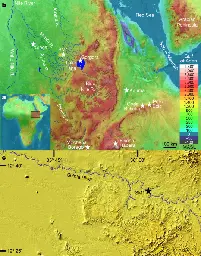Adaptive foraging behaviours in the Horn of Africa during Toba supereruption
Adaptive foraging behaviours in the Horn of Africa during Toba supereruption
The archaeological site Shinfa-Metema 1 in the lowlands of northwest Ethiopia provides early evidence of intensive riverine-based foraging aided by the likely adoption of the bow and arrow.

Archived link: https://web.archive.org/save/https%3A%2F%2Fwww.nature.com%2Farticles%2Fs41586-024-07208-3
DOI for the highseas: https://doi.org/10.1038/s41586-024-07208-3
Adaptive foraging along dry-season waterholes would have transformed seasonal rivers into ‘blue highway’ corridors, potentially facilitating an out-of-Africa dispersal and suggesting that the event was not restricted to times of humid climates. The behavioural flexibility required to survive seasonally arid conditions in general, and the apparent short-term effects of the Toba supereruption in particular were probably key to the most recent dispersal and subsequent worldwide expansion of modern humans.